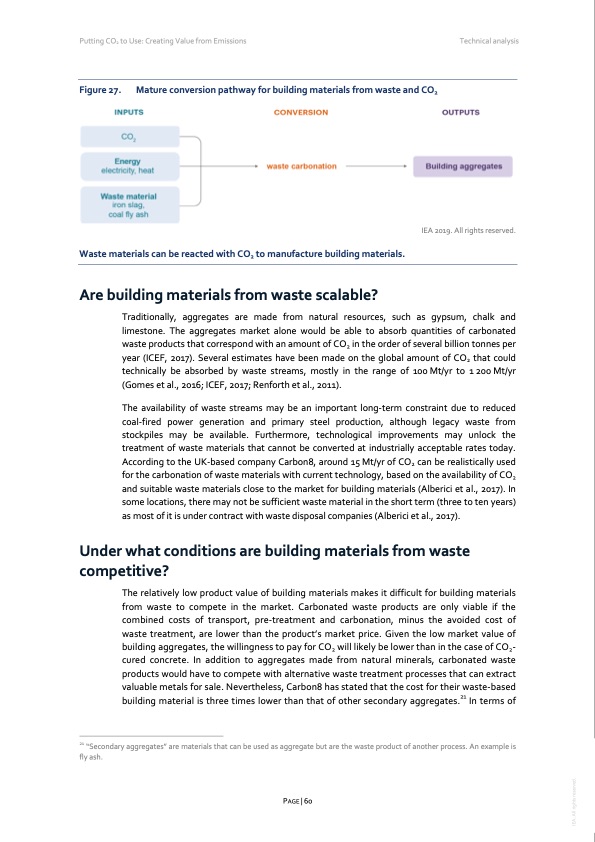
PDF Publication Title:
Text from PDF Page: 061
Putting CO2 to Use: Creating Value from Emissions Technical analysis Figure 27. Mature conversion pathway for building materials from waste and CO2 Waste materials can be reacted with CO2 to manufacture building materials. Are building materials from waste scalable? IEA 2019. All rights reserved. Traditionally, aggregates are made from natural resources, such as gypsum, chalk and limestone. The aggregates market alone would be able to absorb quantities of carbonated waste products that correspond with an amount of CO2 in the order of several billion tonnes per year (ICEF, 2017). Several estimates have been made on the global amount of CO2 that could technically be absorbed by waste streams, mostly in the range of 100 Mt/yr to 1 200 Mt/yr (Gomes et al., 2016; ICEF, 2017; Renforth et al., 2011). The availability of waste streams may be an important long-term constraint due to reduced coal-fired power generation and primary steel production, although legacy waste from stockpiles may be available. Furthermore, technological improvements may unlock the treatment of waste materials that cannot be converted at industrially acceptable rates today. According to the UK-based company Carbon8, around 15 Mt/yr of CO2 can be realistically used for the carbonation of waste materials with current technology, based on the availability of CO2 and suitable waste materials close to the market for building materials (Alberici et al., 2017). In some locations, there may not be sufficient waste material in the short term (three to ten years) as most of it is under contract with waste disposal companies (Alberici et al., 2017). Under what conditions are building materials from waste competitive? The relatively low product value of building materials makes it difficult for building materials from waste to compete in the market. Carbonated waste products are only viable if the combined costs of transport, pre-treatment and carbonation, minus the avoided cost of waste treatment, are lower than the product’s market price. Given the low market value of building aggregates, the willingness to pay for CO2 will likely be lower than in the case of CO2- cured concrete. In addition to aggregates made from natural minerals, carbonated waste products would have to compete with alternative waste treatment processes that can extract valuable metals for sale. Nevertheless, Carbon8 has stated that the cost for their waste-based building material is three times lower than that of other secondary aggregates.21 In terms of 21 “Secondary aggregates” are materials that can be used as aggregate but are the waste product of another process. An example is fly ash. PAGE | 60 IEA. All rights reserved.PDF Image | Putting CO2 to Use Creating value from emissions

PDF Search Title:
Putting CO2 to Use Creating value from emissionsOriginal File Name Searched:
putting_co2_to_use.pdfDIY PDF Search: Google It | Yahoo | Bing
NFT (Non Fungible Token): Buy our tech, design, development or system NFT and become part of our tech NFT network... More Info
IT XR Project Redstone NFT Available for Sale: NFT for high tech turbine design with one part 3D printed counter-rotating energy turbine. Be part of the future with this NFT. Can be bought and sold but only one design NFT exists. Royalties go to the developer (Infinity) to keep enhancing design and applications... More Info
Infinity Turbine IT XR Project Redstone Design: NFT for sale... NFT for high tech turbine design with one part 3D printed counter-rotating energy turbine. Includes all rights to this turbine design, including license for Fluid Handling Block I and II for the turbine assembly and housing. The NFT includes the blueprints (cad/cam), revenue streams, and all future development of the IT XR Project Redstone... More Info
Infinity Turbine ROT Radial Outflow Turbine 24 Design and Worldwide Rights: NFT for sale... NFT for the ROT 24 energy turbine. Be part of the future with this NFT. This design can be bought and sold but only one design NFT exists. You may manufacture the unit, or get the revenues from its sale from Infinity Turbine. Royalties go to the developer (Infinity) to keep enhancing design and applications... More Info
Infinity Supercritical CO2 10 Liter Extractor Design and Worldwide Rights: The Infinity Supercritical 10L CO2 extractor is for botanical oil extraction, which is rich in terpenes and can produce shelf ready full spectrum oil. With over 5 years of development, this industry leader mature extractor machine has been sold since 2015 and is part of many profitable businesses. The process can also be used for electrowinning, e-waste recycling, and lithium battery recycling, gold mining electronic wastes, precious metals. CO2 can also be used in a reverse fuel cell with nafion to make a gas-to-liquids fuel, such as methanol, ethanol and butanol or ethylene. Supercritical CO2 has also been used for treating nafion to make it more effective catalyst. This NFT is for the purchase of worldwide rights which includes the design. More Info
NFT (Non Fungible Token): Buy our tech, design, development or system NFT and become part of our tech NFT network... More Info
Infinity Turbine Products: Special for this month, any plans are $10,000 for complete Cad/Cam blueprints. License is for one build. Try before you buy a production license. May pay by Bitcoin or other Crypto. Products Page... More Info
| CONTACT TEL: 608-238-6001 Email: greg@infinityturbine.com | RSS | AMP |